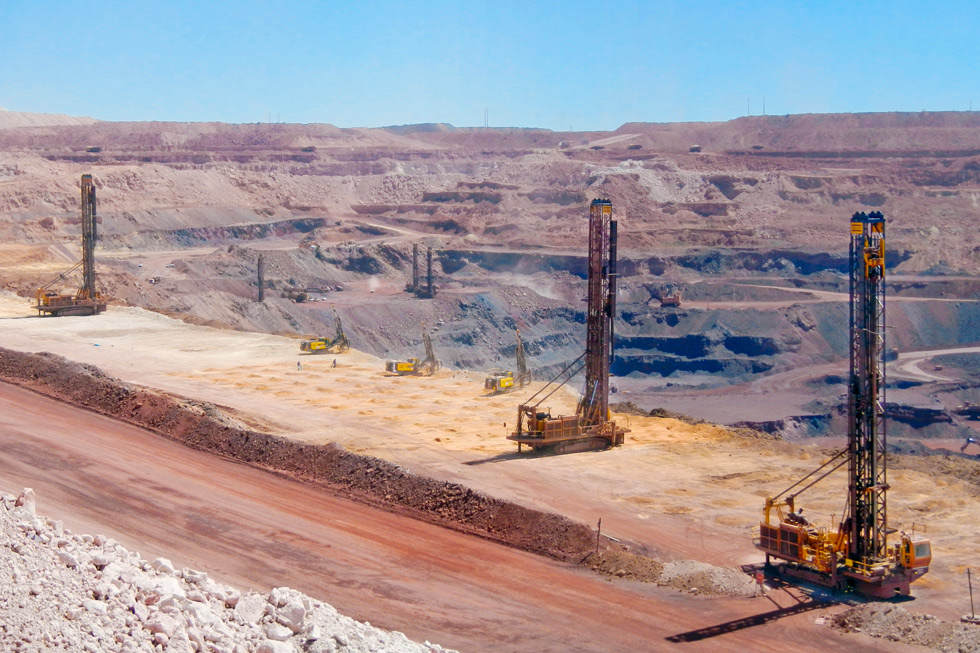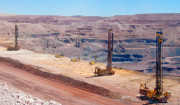When Jacob Zuma, President of South Africa, announced a major infrastructure upgrade for the west coast it was good news for the iron ore producers of the Northern Cape. When complete, the program will boost freight transport in the region to 100 million tonnes per year which means a substantial increase in the capacity of the roads and railways used by the mines to get their products to ports for worldwide export.
This development will also greatly benefit the nation. Practically all of South Africa?s iron ore is mined from the large open pit operations in the Northern Cape where competition is fierce and high productivity and efficiency are essential, particularly in view of the present economic downturn.
Against this background, the equipment being used to drill the blast holes ? Pit Viper and ROC L8 rigs from Atlas Copco ? is a key element for both the mines themselves as well as mining contractors. Dennis Stonefield, Applications Manager with Atlas Copco in Gauteng, points out that there are more than 30 Pit Viper rigs as well as ROC L8 units at work in the region with more Atlas Copco blasthole drills on order.
?For many mines the Pit Viper has become the equipment of choice and this is due to a combination of three things,? explains Stonefield. ?They are very robust, they represent the latest drilling technology and they come with strong technical support. I also think it is true to say that the Pit Viper series has set a new standard in the industry.?
In the Kalahari area, the iron is dominated by the blood red mineral hematite between the towns of Kuruman and Postmasburg in the north of the province. The comparative purity of the ore here makes it exceptionally hard which presents a major challenge for high productivity drill and blast operations.
To tackle these conditions on the benches, the mines in this area as well as elsewhere in the province, are using the ROC L8 mainly for presplit drilling equipped with DTH (Down-the-Hole) hammers and Pit Viper rigs alternatively, using rotary drilling or high pressure DTH drilling.
Iron clad optimism
Despite the recent decline in the global market for iron ore, largely due to a slowdown in China, the iron producers of the Northern Cape are optimistic and investing in increased efficiency for the future.
Kumba Iron Ore at Sishen, near Kathu, is a typical example. Owned by Anglo American, Africa?s largest iron ore producer and the tenth largest in the world, Kumba operates a massive, single-pit, open cast mine that stretches 13 km north to south, and 2.5 km across at its widest point. As the mine deepens, the width is expected to reach 5 km.
Opened in 1947, the Sishen pit is now big enough to house most of the mine?s ore preparation plant and ancillary facilities. More importantly for the market, Kumba claims the most consistent and highest quality iron ore in the world with the Sishen operation producing some 40 million tonnes per year.
Further to the south is Sishen?s sister mine, Kolomela. Formerly known as Sishen South, this site officially opened in 2012 but started shipping ore five months ahead of schedule. When the Kolomela pit reaches full production in 2013, it will increase Kumba?s ore output by 9 Mt per year.
Another major operator in the area is Assmang. Jointly owned by African Rainbow Minerals (ARM) and Assore, Assmang is a steel industry specialist supplier whose iron ore resources complement its manganese operations, both north and south of Sishen.
The company?s Khumani complex, with a mining lease covering some 7?300 hectares (formerly known as BMK), includes three main properties; ?Bruce? which started operating in 2007 and ?King? which opened in 2011. There is also a development property, Mokaning, as well as two farm properties that have not yet been exploited.
The Kumba operation
In common with most other mining operations in the area, Kumba?s Sishen pit operates 24 hours a day which places high demands on all of the equipment and especially the drill rigs. Expected availability and utilization figures are high, so maintenance is carefully planned to avoid downtime.
The huge open pit is normally worked with single-pass rotary drilling on benches 18 m high. The drilling fleet, including up to 17 Pit Viper 351 rigs, drills 311 mm vertical blast holes using Secoroc tricone bits and Teamalloy pipes. This is achieved with a burden of 7.2 m and a spacing of 8.3 m.
In addition, the rigs are equipped with navigation systems and a laser-based, high wall detection device on the side of the cabins for added visibility and safety.
One feature of the PV-351 that is particularly appreciated is its easy and rapid tramming capability which contributes to the mine?s flexibility. For short moves between hole positions, the tower can be kept in the upright position but can also be lowered for longer tramming. In each case, this so-called ?live? tower system enables it to be raised or lowered with the complete drillstring in place.
Atlas Copco will provide support to the service and maintainance team of Sishen through product specialists with field service technicians available on an ?as needed? basis. Efficient parts supply and minimum downtime is ensured by having established a parts store in Sishen. A fully equipped assembly yard, dedicated to the assembly of seven PV-351 rigs has also been established and at one point in time here, three PV-351 units were at different stages of assembly. The first rig assembled by the Atlas Copco team reached commissioning in just nine days.
These new rigs will join ten PV-351 rigs already in operation at the site and as each one is assembled it is trammed to the mine?s test area and put though its paces until the mine management is satisfied.
All of the rigs are equipped with Atlas Copco?s RCS (Rig Control System), which facilitates a wide range of functions such as safety interlocks, auto-leveling, drill performance monitoring and drilling data collection.
Kumba?s latest rigs also include Ansul fire protection, a drillstring thread greasing system, a modified electrical isolation system, emergency shutdown, wraparound decking for easy access to all service areas together with hydraulically retractable surface-to-walkway stairways.
Once all of the rigs have been delivered, Kumba will have the largest fleet of Pit Viper 351 rigs in the world. The rigs are delivered totally encased on special low-bed trailers directly to the site from Cape Town.
The development of Kolomela Mine, located 9 km southwest of Postmasburg and 85 km south of Sishen, is one of Anglo American?s ?big four? expansion projects (the other three being in South America). Unlike Sishen, the multi-pit Kolomela complex is applying the DTH drilling method using Atlas Copco DML as well as two ROC L8 rigs.
Here, the rigs work on 12 m high benches and drill 203 mm holes to depths of 13?14?m with a pattern of 5 x 5 m. Depending on the type of formation, peneration rate varies widely from 10???20 m per hour.
The Khumani operation
At the King Mine on the Khumani complex, the drilling fleet is dominated by Atlas Copco?s diesel powered Pit Viper 271 rigs. Unlike at Sishen, Khumani chooses to use the high pressure version of the PV-271 with DTH (Down-The-Hole) hammers to tackle the ore beds that are well known for their extreme hardness.
However, the ore here is generally well exposed and the mine benefits from a low stripping ratio of 0.7??0.9 whereas other mines in the area need to manage a ratio of around 2.7. The benches are 10.4 m high and holes are drilled vertically to a depth of 11.4 m including 1 m of sub-drilling. In drilling the overburden the usual drill pattern is 5.5 m x 6.5 m as allowed by the rock type such as sandstone, shale and weathered material.
The underlying ore is often very hard here and some drill bits last only two hours. DTH drilling is used with 165 mm bits and Secoroc 64 hammers and others, but the mine is continuously trying to reduce drilling costs.
Gerrit Loedolff, Manager of Mining Operations at Khumani, explains that a current priority is to examine rotary drilling options for 251 mm holes. ?Large diameter holes reduce drilling cost and, used in conjunction with electronic blasting, reduces blasting cost as well.
?We will be using the converted PV-271 because of sufficient compressor capacity to ensure adequate chip flushing. The biggest enemy of a tricone bit is drill chippings in the hole, and incorrect bailing velocities can have an impact on drill rod life.?
In switching from 165 mm to 251 mm holes, it is expected that the drill pattern will change to 6 m x 6 m and that the volume of blasted rock per hole will increase from 16 m3 to approximately 36 m3.
In addition to changing drill pipes the conversion will require lowering the pressure of the compressor to the minimum level, as well as changing the carousel, rod support, the breakout systems and tool handling accessories. The tricone bits will initially be from Secoroc, but Loedolff says that the mine will test a variety of products including bits used by neighbouring mines.
Drill rig availability at Khumani is increasing. ?Availability of the PV-271 rigs is in excess of 85 percent and ROC L8 rigs are above 75 percent,? reports Loedolff. ?As expertise and maintenance practices improve, so does availability ? remember, both machines are fairly new to the maintenance crew and most of the operators are in the learning phase.?
In the past couple of months, the availabilities of both machines have increased. The ROC L8 operates mostly on outcrops and is exposed to difficult drilling conditions such as uneven floors and weathered rock. Although Khumani?s Bruce Mine is already in full production, and King Mine will reach it this year (2013), Loedolff says that the ROC L8 rigs will still be used in some drilling of virgin ground as well as pre-splitting holes. The latter are only drilled at final pit limits with a 1.8 m spacing, according to the conditions.
Procedures guided by safety
The drillers have to tackle three main ore types; laminated iron ore, drilled at 120??130 m per shift (using the PV-271 and single-pass DTH drilling), loose conglomerate, and compact conglomerate. Very abrasive phyllites and quartzites are also encountered as well as ?soft? iron on the Mokaning development property.
In the more difficult conglomerates, the typical drill pattern of 5.5 m x 6.5 m is reduced to 3.5 m x 4.0 m. The holes are charged near the stem to reduce oversize material at the top of the holes.
The frequent reviews of drilling para?meters also require complete reviews of procedures. ?New drilling procedures will always be done with safety as the guiding factor,? says Loedolff. ?A complete risk assessment will be done, which will be the guide for the new procedure to ensure that the hazards are eliminated or reduced. Hole spacing and hole diameter are factors that will be considered to ensure the correct powder factor can be applied practically.?
He also emphasises the importance of good operators in reducing the cost of drilling consumables, as well as unit cost versus durability. ?A good operator will be able to extract more meters out of his consumables. That?s why we spend a huge amount of time and money on training drill rig operators. Good operators equal a huge saving in consumables.?
The Atlas Copco equipment, which also includes breakers and stationery compressors, is clearly contributing to efficiency, but the search for further improvement continues. ?The mining industry as a whole will never stop looking at blasthole procedures,? says Loedolff, ?and if we can do it more safely, faster and cheaper, we will pursue these options.?
Epiroc operated under the trademark “Atlas Copco” prior to January 1, 2018.



Here:
Us: